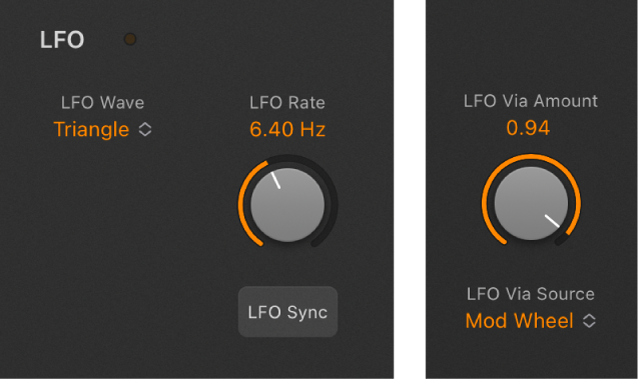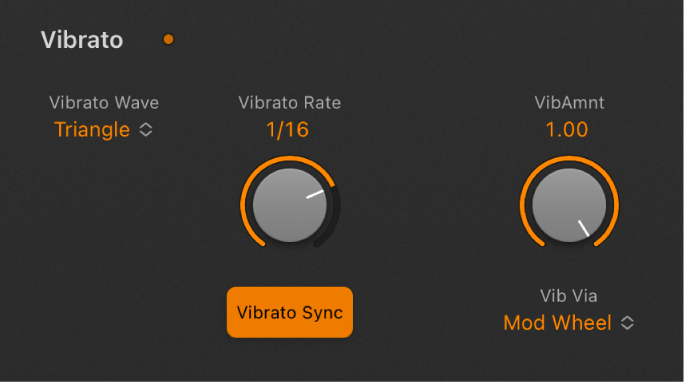Logic Pro User Guide for iPad
-
- What is Logic Pro?
- Working areas
- Work with function buttons
- Work with numeric values
-
- Intro to tracks
- Create tracks
- Create tracks using drag and drop
- Choose the default region type for a software instrument track
- Select tracks
- Duplicate tracks
- Reorder tracks
- Rename tracks
- Change track icons
- Change track colors
- Use the tuner on an audio track
- Show the output track in the Tracks area
- Delete tracks
- Edit track parameters
- Start a Logic Pro subscription
- How to get help
-
- Intro to recording
-
- Before recording software instruments
- Record software instruments
- Record additional software instrument takes
- Record to multiple software instrument tracks
- Record multiple MIDI devices to multiple tracks
- Record software instruments and audio simultaneously
- Merge software instrument recordings
- Spot erase software instrument recordings
- Replace software instrument recordings
- Capture your most recent MIDI performance
- Use the metronome
- Use the count-in
-
- Intro to arranging
-
- Intro to regions
- Select regions
- Cut, copy, and paste regions
- Move regions
- Remove gaps between regions
- Delay region playback
- Trim regions
- Loop regions
- Repeat regions
- Mute regions
- Split and join regions
- Stretch regions
- Separate a MIDI region by note pitch
- Bounce regions in place
- Change the gain of audio regions
- Create regions in the Tracks area
- Convert a MIDI region to a Drummer region or a pattern region
- Rename regions
- Change the color of regions
- Delete regions
- Create fades on audio regions
- Access mixing functions using the Fader
-
- Intro to Step Sequencer
- Use Step Sequencer with Drum Machine Designer
- Record Step Sequencer patterns live
- Step record Step Sequencer patterns
- Load and save patterns
- Modify pattern playback
- Edit steps
- Edit rows
- Edit Step Sequencer pattern, row, and step settings in the inspector
- Customize Step Sequencer
-
- Effect plug-ins overview
-
- Instrument plug-ins overview
-
- ES2 overview
- Interface overview
-
- Modulation overview
-
- Vector Envelope overview
- Use Vector Envelope points
- Use Vector Envelope solo and sustain points
- Set Vector Envelope segment times
- Vector Envelope XY pad controls
- Vector Envelope Actions menu
- Vector Envelope loop controls
- Vector Envelope release phase behavior
- Vector Envelope point transition shapes
- Use Vector Envelope time scaling
- Use the Mod Pad
- Modulation source reference
- Via modulation source reference
-
- Sample Alchemy overview
- Interface overview
- Add source material
- Save a preset
- Edit mode
- Play modes
- Source overview
- Synthesis modes
- Granular controls
- Additive effects
- Additive effect controls
- Spectral effect
- Spectral effect controls
- Filter module
- Low and Highpass filter
- Comb PM filter
- Downsampler filter
- FM filter
- Envelope generators
- Mod Matrix
- Modulation routing
- Motion mode
- Trim mode
- More menu
- Sampler
- Copyright
Retro Synth LFO and Vibrato in Logic Pro for iPad
The Retro Synth LFO (Low Frequency Oscillator) is a multiwaveform, polyphonic modulation generator that modulates each voice, or note you play, individually. It can be used as a source for multiple modulation targets.

Retro Synth also provides a dedicated Vibrato LFO for pitch modulation.

Although they are oscillators, LFOs are not audible—but their effects can certainly be heard. The sole purpose of an LFO is to modulate other sound generating elements of the synthesizer.
LFO/Vibrato parameters
LFO/Vibrato Wave pop-up menus: Choose an LFO or Vibrato waveform.
The sawtooth waves are suitable for bubbling, rhythmic effects.
The triangle wave is suitable for vibrato and other evenly-modulated effects.
The rectangular waves switch between two values, which is useful for stepping the oscillator pitch by a fifth, for example.
LFO/Vibrato Rate knobs and fields: Independently set the maximum LFO or Vibrato speed.
LFO/Vibrato Sync buttons: Turn on to synchronize the modulation speed with the host tempo. Turn off to control the modulation speed manually.
LFO Via Amount knob and field: Set the maximum LFO modulation amount. This parameter is controlled with the MIDI controller chosen in the LFO Via Source pop-up menu.
LFO Via Source pop-up menu: Choose your MIDI keyboard Mod Wheel, Aftertouch, or Modwheel + Aftertouch as the control source for the LFO amount level.
Vibrato Via Amount knob and field: Set the maximum vibrato amount. This parameter is controlled with the MIDI controller chosen in the Vibrato Via Source pop-up menu.
Vibrato Via Source pop-up menu: Choose your MIDI keyboard Mod Wheel, Aftertouch, or Modwheel + Aftertouch as the control source for the vibrato amount level.
Download this guide: PDF